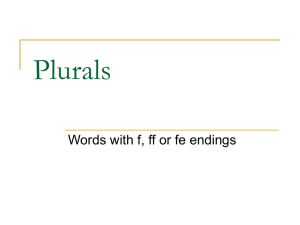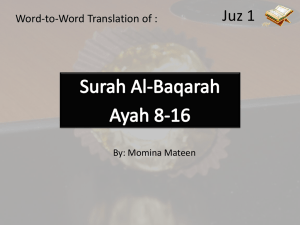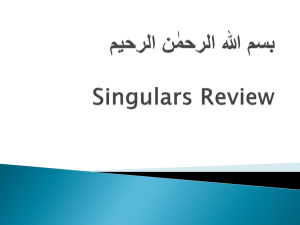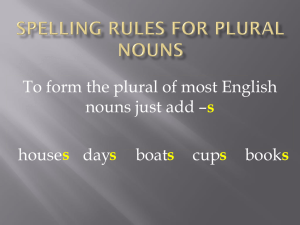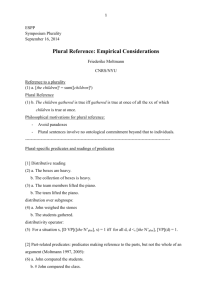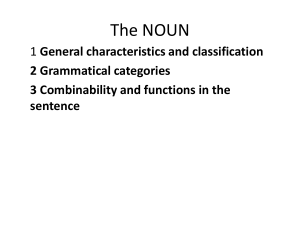The Influence of Language on Memory: Differences in Recollection
advertisement
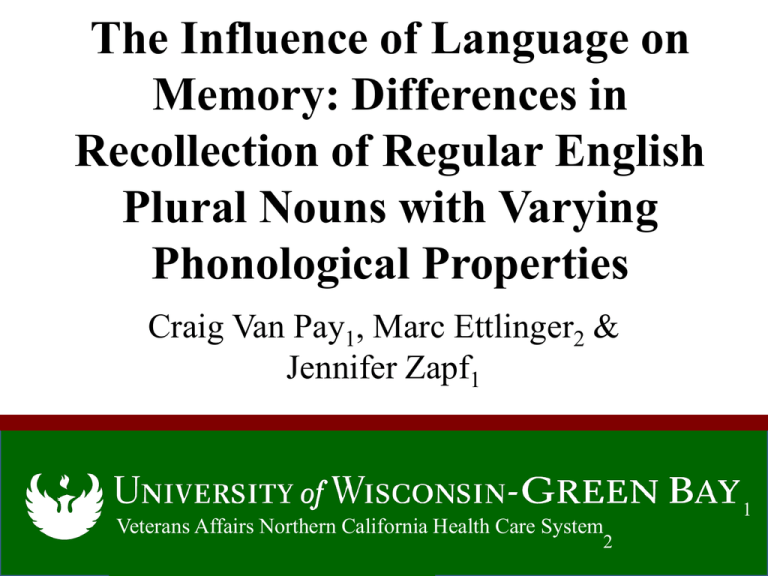
The Influence of Language on Memory: Differences in Recollection of Regular English Plural Nouns with Varying Phonological Properties Craig Van Pay1, Marc Ettlinger2 & Jennifer Zapf1 Veterans Affairs Northern California Health Care System 2 1 Abstract Does the language we speak affect what we can remember? The current study tests three- to five-year-old children’s ability to recall English plural nouns with vowel, sibilant, and plosive endings. Results suggest that variations of difficulty in English plural noun endings do affect children’s ability to remember them. Introduction • Does the language we speak shape the way we think? The Sapir-Whorf Hypothesis puts forth the idea that it does (Whorf, 1956). This idea has been supported when looking at: • Differences of language use for accidental events in English and Spanish (Fausey & Boroditsky, 2011). • Pirahã language’s lack of explicit number terms and memory difficulty for number matching (Frank, Everett, Fedorenko & Gibson, 2008). • Discrimination of color (Winawer et al., 2007). • Categorization of color (Roberson, Davies, & Davidoff, 2000). • Children cannot produce all plural words with the same efficiency. Two such findings with respect to plural word production are: • Children have difficulty producing the plural for novel nouns that required the /əz/ morpheme (e.g. nizzes). Thus, so called sibilant words are difficult for children to produce (Berko, 1958). • Two-year-old children produced the plural for words with complex codas (e.g., dogs) significantly less than for the plural of words with simple codas (e.g., keys) (Ettlinger & Zapf, 2011). Current Study • Hypothesis Differences that exist in children’s plural production due to variations in phonology and ease of articulation will result in a discrepancy of being able to think about, and thus recall those objects. Method: Participants • 50 English speaking children 27 females, 23 males 30 to 56 months of age, mean = 39.5 months • Conducted in UWGB Language Learning Lab or daycares • Children received a book for participating • Parents filled out sheet measuring children’s productive vocabulary (MCDI) (Fenson et al., 1994) Method: Procedure • Training Phase Participants were shown a book of 36 pictures with various words and plurality. Two books were utilized: one with 18 plurals and 18 singulars and the other with the original 18 plurals as singulars and vice versa. • Distraction Phase Participants listened to a classical song for four minutes while coloring a picture. • Testing Phase The experimenter presented the 2-AFC board and placed both pictures on the board at the same time, randomizing which side the right and wrong answer were on. The experimenter asked the participant, “Which page did you see?”, “Can you put which page you saw in the green box?”. The participant then moved the picture they saw earlier into the green box. Method: Materials Signal Detection Theory • Signal Detection Theory Combines the hits (correctly picked plurals), misses (missed plurals), false alarms (picked plural when saw singular) and correct rejection (correct singulars). Signal Detection Theory takes into account sensitivity and bias of responses. The sensitivity to a signal is what we are interested in, the bias to certain signals is what we must be aware of and take into account. Results d’ measures were analyzed using a paired post-hoc t-test. The plurality of vowel-final words (d’ = 2.3, S.E. = .27) is remembered more often than plosive-final words (d’ = 1.8, S.E. = .29), t(36) = 2.2, p = .036, d = .73, the plurality of plosive-final words is remembered more often than sibilant-final words (d’ = 1.2, S.E .= .32), t(36) = 2.1, p = .045, d = .70 and the plurality of vowel-final words is remembered more often than sibilant-final words t(36) = 3.9, p < .001, d = 1.3. Results Cont. Overall memory performance was moderately, but not significantly, correlated with age, r(36) = .23, p = .16 and vocabulary, r(36) = .31, p = .060 as measured by the MCDI. d’ Measure of Performance in Each Condition Compared to Productive Vocabulary Conclusion • These data show that, as hypothesized, the varying phonological difficulties that exist in the three regular English plural endings result in variances of recollection for images that require those words. • More specifically, children are better able to recall the plurality of objects they saw for words where the plural is easier to produce. • The three plural endings that exist in English are the /z/ or vowel ending, the /s/ or plosive ending, and the /əz/ or sibilant ending. It is in that order they are easy to produce, and in the same order they are easier to recall. There were significant differences between all three in recall, with a progression of sibilant-ending recollection < plosive-ending recollection < vowel-ending recollection. • Age of the participant was slightly correlated with better recall for all three word types. • Productive vocabulary as measured by the MCDI was moderately, yet barely insignificant, correlated with better recall for all three word types. Discussion • These results suggest that the language children speak DOES affect how they think, supporting the Sapir-Whorf Hypothesis and displaying a direct effect of language upon memory. • It is still not entirely understood why this effect exists. It may be due to an inability for the child to recite the word mentally and store it into long-term memory or some sort of mental representation problem as illustrated in the introduction. Future research will be conducted to tease apart this phenomenon and to understand why this recollection problem exists. • Future Research Possibilities: • To manipulate number and similarity of objects denoting plurality • To test older children to see if this phenomenon still persists • To test children during brain imaging, to see if a neural or biological mechanism or occurrence may be at work • To block children from saying all words, or elicit the production from them of all word categories • To test various languages and artificial languages to see if these recollections exist in other language, and only within English References Berko, J. (1958). The Childs Learning of English Morphology. Word- Journal of the International Linguistic Association, 14(2-3), 150-177. Ettlinger, M. & Zapf, J.A. (2011). The role of phonology in children’s acquisition of the plural. Language Acquisition, 28. Fausey, C.M. & Boroditsky, L. (2011). Who dunnit? Cross-linguistic differences in eyewitness memory. Psychological Bulletin Review, 18(1), 150-157. Fenson, L., et al. (1994).Variability in early communicative development. Monograph Society for the Research of Child Development, 59:1-173; discussion 174-185. Frank, M.C., Everett, D.L., Fedorenko, E., & Gibson, E. (2008). Number as a cognitive technology: evidence from Piraha language and cognition. Cognition, 108, 819-824. Roberson, D., Davies, I., & Davidoff, J. (2000). Color categories are not universal: replications and new evidence from a stone-age culture. Journal of Experimental Psychology:General, 129(3), 369-398. Winawer, J.,Witthoft, N., Frank, M. C., Wu, L., Wade, A. R., & Boroditsky, L. (2007). Russian blues reveal effects of language on color discrimination. PNAS, 104(19), 77807785 Zapf, J. A., & Smith, L. B. (2008). Meaning matters in children’s plural productions. Cognition, 108, 466-476. Acknowledgments I would like to acknowledge my sponsor, Dr. Jennifer Zapf, for guidance and substantial contributions to this experiment and poster. I would also like to acknowledge Dr. Marc Ettlinger for substantial portions of this poster, including figures, along with the experimental idea. Finally I would like to acknowledge Areanna Lakowske and Caitlin Gurlt for assistance with data collection and coding.
